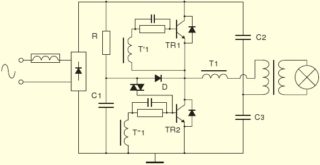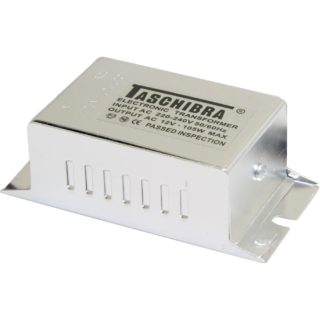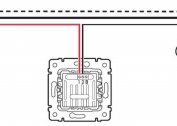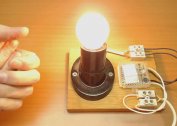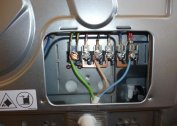Electronic transformer (ET) appeared on the domestic market relatively recently, but has already managed to gain popularity among amateurs and professionals. On the pages of the Internet published a large number of materials on electronic converters represented by homemade sources and chargers of various types. They describe in detail the principle of their work and the procedure for connecting to the network. By their composition, these devices belong to typical network modules, in which ET is used as the main node. Due to its simplicity and versatility, these products are no more expensive than the Chinese power supply (PSU). Like him, when charging, they work from an industrial network of 220 volts.
The device and principle of operation of ET
Structurally, this circuit element contains the following nodes:
- multivibrator - master pulse generator using powerful transistors;
- a bridge assembled on high-voltage inductors;
- small-sized voltage transformer 220 12.
The generator function in the electronic transformer circuit is performed either by a diode thyristor or transistors connected according to the circuit of commutators of powerful pulses (they are also called key ones). During the operation of this electronic unit, the generation frequency is set using a variable resistor and storage capacitance (it can be adjusted in the range from 30 to 35 kHz). Inductors are included in a partially bridge circuit and are wound on a small ring core.
This module provides a feedback loop, which improves the stability of the master oscillator.
The circuit used high-voltage bipolar transistors (usually - type MGE 13001-13009). The specific brand is selected depending on the power of the electronic transformer, the main purpose of which is to lower the output signal level to a predetermined value of 12 (24) Volts. Its main advantage is small dimensions and light weight, which allows to reduce the relevant parameters of the entire device.
The principle of operation of the transformer consists in the formation by the generator of the pulse voltage of the desired amplitude, which after conversion in the transformer is reduced to the required level. For the normal operation of halogen lamps, powerful current pulses with an amplitude of 12 or 24 Volts are quite enough.
Power supply based on electronic transformer
In the manufacture of a full-fledged power supply based on an electronic 12-volt DC transformer, a rectifier bridge with filtering elements is added to its circuit. This unit consists of 4 medium-power diode diodes with a reverse voltage of up to 1 kV and a current of about 1 Ampere. After them, the direct voltage obtained as a result of rectification is smoothed (filtered) by an electrolytic capacitor and a powerful inductive choke.
Thanks to this unit, it is possible to control the charging chain of a variable resistor and capacitor included in the electronic transformer.
The advantage of the power supply assembled according to the considered scheme is simplicity and reliability. The main disadvantage is the difficulty of obtaining a sufficiently large amplitude at the output of the pulse current. The circuit is suitable only for low-power halogen lamps installed in small night-light fixtures.
Advantages of electronic converters
 Among the main advantages of devices based on ET, include the following features of the circuit:
Among the main advantages of devices based on ET, include the following features of the circuit:
- the output transformer of the power supply will not start without connecting a load to it - it will go into active mode if a lamp with a lamp is connected to it;
- in addition to the sparing mode of operation of the elements of the electronic circuit, this ET property allows saving on the consumed electricity;
- the product easily implements a system of protection against dangerous overloads and short circuits.
As a sample used for the self-made manufacture of a power supply on such a transformer, often more complex half-bridge circuits are taken. Usually they are built on the basis of drivers such as IR2153 or similar electronic components. As an additional option, they have an indicator LED that signals the presence of high-frequency oscillations.
Some of the advantages of electronic converters are considered by specialists to be disadvantages that hinder their independent conversion into simple power supplies.
Disadvantages of ET models offered by the market
Despite the economical and well-developed scheme, power supplies for ETs have a number of disadvantages, which are usually referred to:
- the absence of special overload protection in the simplest Chinese models;
- the need for compulsory refinement of the circuit;
- in many market samples there is no input filtering device, which forces the addition of a smoothing electrolytic capacitor (it is placed after the “powerful” inductor).
The listed disadvantages usually include the “hard” mode of operation of high-voltage transistors included in the key circuit.
In the event of a random output circuit (short circuit), these elements simply “burn out”, which leads to the need for an urgent update of the entire electronic module. Often, a rectifier on semiconductor diodes, which also needs to be replaced, also fails.
It is impractical to repair ET, since it costs almost a penny. It is much easier and cheaper to purchase a new module and remake it to fit your needs.
Power electronic transformers
Under the power indicator ET is meant the magnitude of the current in the load, multiplied by the supply voltage of the halogen bulb. On the domestic market there are various samples of transformer products with declared performance from 25 to several hundred watts. The most widely represented models are designed for output power of the order of 50-80 watts. It is allowed to connect two or even three 20-watt lamps to such converters. As a rule, all of them are designed for an output voltage of 12 volts.
The considered power supplies are used only for its intended purpose - to power halogen light sources. It is forbidden to use them for LED lamps, for example, by the instruction attached to the product.

